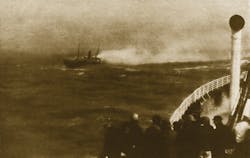BROOKLYN, NY: OCT. 2, 1913 – Flames broke out shortly before 1 P.M. in the Sunday school building nestled behind the Plymouth Church on Orange Street in Brooklyn Heights. The flames burned through the roof before the fire was noticed and the alarm was turned in. Fire companies were faced with an advanced fire threatening to spread to the old-fashioned, red-brick church nearby. (The famed abolitionist preacher Henry Ward Beecher was the church’s first pastor in 1847. The original church was destroyed by fire in 1849 and the new brick church was built to replace it. Beecher and his church were part of the Underground Railroad that helped freed slaves escape from the South.) Under the command of Deputy Chief O’Hara, companies pressed the attack with help from the high-pressure water system. Within a half-hour, the aggressive firefighting had the flames under control and the church was saved.
ST. PAUL, MN: OCT. 4, 1913 – An early-morning fire tore through Union Station, a city landmark. The fire was believed to have started in the kitchen of the station’s restaurant and spread quickly throughout the three-story structure. Despite the fact that every train that entered had to pass through the station, train traffic was only slightly delayed.
GLEN COVE, NY: OCT. 4, 1913 – An incendiary blaze, believed to be the work of the notorious “Black Hand Gang,” (extortionists who preyed on wealthy Italian families and used bombs and fire as their main weapons) caused the death of two people and injured more than six others as flames engulfed a tenement building. The building’s owner had received a letter demanding payment, but ignored the warning. The building was soon ablaze. Arriving firemen were faced with heavy fire and numerous people trapped at windows. Firemen using a blanket caught several children. All of the injured jumped from windows. Firemen were able to hold the flames to the first floor.
SAN DIEGO, CA: OCT. 5, 1913 – The city’s first major industrial fire took place when an explosion occurred at the Standard Oil Co. tank farm at 26th and Schley streets. Burning oil flowed into the neighborhood, igniting lumber yards and spreading the flames to the huge stacks of wood. For three days and nights, firemen battled the difficult and dangerous blaze while throngs of spectators watched their efforts.
SEATTLE, WA: OCT. 5, 1913 – Eight firemen were injured battling an incendiary blaze in the pressroom of the Seattle Times newspaper. The paper would continue in operation publishing the following day’s issue using the presses of the Post-Intelligencer. This was the second fire to sweep through the newspaper; the first occurred on Feb. 13 when a 4-11 alarm was sounded, bringing fire companies from across the city. Nine engines, three trucks, two chemical companies and a water tower responded to the fire.
NEW YORK CITY: OCT. 24, 1913 – Three alarms were transmitted for an explosion and fire at 206-212 Canal St. in Manhattan. Two six-story loft buildings occupied by chair factories, mirror works, embossing and machine concerns were involved. Eight employees lost their lives and many were injured when an explosion in a Japanning-baking oven next to a dipping tank filled with benzene. (Japanning is an imitation of Asian lacquerwork involving numerous coats of varnish applied and heat-dried to a smooth glossy finish.) The blast drove fire in every direction and spread through machinery holes in the floors. Flames also extended out and upward, cutting off fire escapes. Firemen made many spectacular aerial and portable ladder rescues.
LONG BEACH, NY: OCT. 27, 1913 – An early-evening fire broke out on the ground floor of the National Bathing Pavilion. The huge structure on the city’s boardwalk overlooking the ocean was quickly filled with flames that threatened several adjacent buildings, including The Nassau Hotel, one of the largest hotels on Long Island. Long Beach volunteer firemen, including former FDNY Chief of Department Edward Croker, valiantly battled the extending flames. The blaze became so fierce that mutual aid was requested from Cedarhurst, Lynbrook, Oceanside and Rockville Centre. Sixteen hose streams battled to save the nearby hotel, which suffered only minor damage.
PAUL HASHAGEN, a Firehouse® contributing editor, is a retired FDNY firefighter who was assigned to Rescue 1 in Manhattan. He is also an ex-chief of the Freeport, NY, Fire Department. Hashagen is the author of FDNY: The Bravest, An Illustrated History 1865-2002, the official history of the New York City Fire Department, and other fire service books. His latest novel, Fire of God, is available at dmcfirebooks.com.
About the Author
Paul Hashagen
PAUL HASHAGEN, a Firehouse® contributing editor, is a retired FDNY firefighter who was assigned to Rescue 1 in Manhattan. He is also an ex-chief of the Freeport, NY, Fire Department. Hashagen is the author of FDNY: The Bravest, An Illustrated History 1865-2002, the official history of the New York City Fire Department, and other fire service books.
Connect with Paul
Website: paulhashagen.com
Facebook: Paul Hashagen-author
